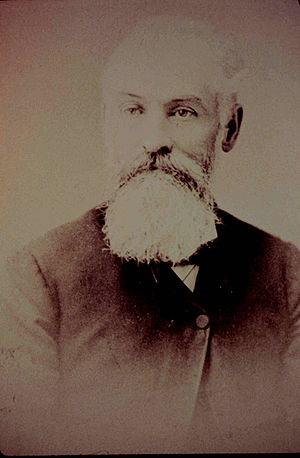- James Crossen-Cobourg Car Works
-
James Crossen-Cobourg Car Works was an early railway car and streetcar builder based in Cobourg, Ontario.
Although the manufacturing of railway rolling stock in Cobourg began in the mid 1860's, the Cobourg Car Works were not established until 1873. The company evolved from a foundry, that supplied cast metal fittings and components to grist and flour mills throughout Northumberland County, into the largest railway car manufacturer in the Dominion of Canada. The founder of the Cobourg Car Works was James Crossen Jr. who was born in Ireland in 1826 and immigrated to Batavia, New York in 1842. At the age of 17, Crossen left his family behind and moved to Cobourg, Ontario where he began work in the Helm Foundry.
He moved up the ranks of this company and eventually achieved partnership in that business. Eventually the company was renamed "Ontario Foundry" and, by 1865 James Crossen was listed in a Northumberland/Durham Counties Directory as the sole proprieter of the company.
Soon afterwards, the Ontario Foundry was approached by the Cobourg-Peterborough-Marmora Railway and Mining Company to build twelve wooden railway dump cars for the transportation of ore. Crossen, realizing the capabilities of his foundry to manufacture the metal wheels and under carriage components of the cars, and knowing of a nearby supply of timber, agreed to fill the order. Eventually, one order for cars and rolling stock replaced the previous and by 1873 various railway companies were coming to the Ontario Foundry to have cars built. Thus the Cobourg Car Works came into existence and the Ontario Foundry faded into history.
Some of company's earliest customers included the Grand Trunk Railway (GTR), the Canadian Pacific Railway (CPR) and the Intercolonial Railway. By 1878, the Cobourg Car Works added First Class Passenger Coach Construction to its operations putting it into direct competition with the American firms of the Pullman Company and the Barney and Smith Car Company. In 1879, the Canadian government passed legislation to restrict American Imports of manufactured goods and products. Called the "Tilley Tariff", duties and taxes where put on the importation of products from outside of Canada. This tariff allowed the Cobourg Car Works to flourish, as they could provide an equivalent product at a cheaper cost to railway companies.
James Crossen died at the age of 64, leaving control of his company to his six children in 1890. The family re-organized and incorporated the company in 1891 under the name Crossen Car Manufacturing Company of Cobourg. James oldest son, William, served as the company's General Manager while his son Frederick served as Secretary Treasurer. His son-in-law, William Renwick Riddell, a prominent Cobourg lawyer, husband of Anna Crossen was elected as the Company President.
In 1896, Frederick Crossen, died at the age of 26 and the continuation of the company was left to William who controlled it until its demise in 1913. In a display of photographs and materials presented by the Art Gallery of Northumberland, in the 1989 exhibition "Some Prominent Citizens" the exhibit claimed, that Crossen Car Manufacturing Company ceased operations in that year and the company's directors liquidated factory's assets soon afterwards. The Gallery referenced, their source of information and materials, as obtained from a great grand daughter of James Crossen, company records and a scrapbook in her possession.
It was also stated that the company's demise came as a result of the introduction of the all-steel cars in 1910. At the time, the company did consider converting their operations to all-steel production, but when one of the company's largest and oldest customers, the Canadian Pacific Railway decided to open their own manufacturing facilities to build cars, it put an abrupt end to the Crossen Company's deliberations.
At the company's peak, it provided employment to as many as 500 workers, and the company's production output rose to as high as 7 passenger cars and 150 freight cars per month
The company built cars for the Toronto Railway Company (SE-ST-M) and Birney cars for rival and city owned Toronto Civic Railways. Railcars were bought by:
- Canadian Pacific Railway
- Intercolonial Railway
- Cobourg & Peterborough Railway Company
- Grand Trunk Railway
- Toronto, Grey and Bruce Railway
The production facilities were later acquired by Dominion Wheel & Foundries Limited and vacated in 1960.
Products
- SE-ST-M streetcar
- Birney cars - Toronto Civic Railways
- four-wheeled ore cars
- passenger cars
- freight cars
- colonist cars
- dining cars
- private cars
- vestibule trains
- parlor cars
- sleeping cars
External links
Categories:- Rail vehicle manufacturers of Canada
- Companies based in Ontario
- Defunct manufacturing companies of Canada
- Cobourg, Ontario
Wikimedia Foundation. 2010.

